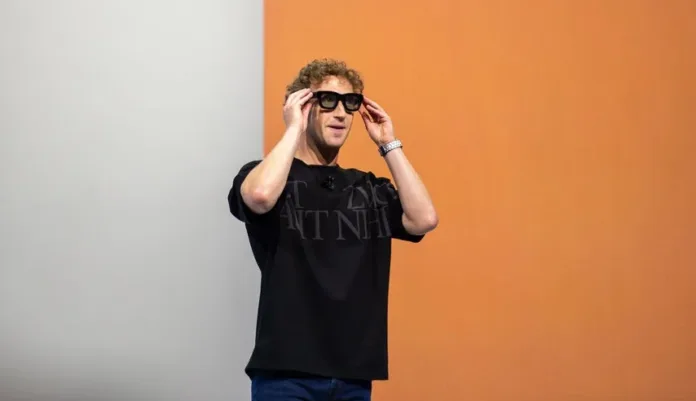Table of Contents
Meta Ray-Ban Display Glasses Change the Smart Wearable Market
At Squaredtech, we follow every move from Meta’s technology pipeline because the company continues to redefine what wearable devices can achieve. Mark Zuckerberg has now unveiled the Meta Ray-Ban Display glasses, the first smart glasses from Meta to feature a built-in high-resolution display.
Read More About Our Article of Meta’s Bold Move: The End of Smartphones and the Rise of META Smart Glasses Published on March 20th, 2025 SquaredTech
The announcement immediately generated attention across the tech industry. The glasses cost $799 and represent Meta’s most advanced consumer-ready wearable to date. Unlike previous models that focused primarily on audio features, this new version integrates a digital display inside the lens, creating a new standard for how smart glasses can interact with everyday communication and entertainment.
Meta has invested years in building toward this release. The Display glasses combine elements from the earlier Ray-Ban Meta audio models with technology drawn from the experimental Orion augmented reality glasses, which remain too costly for public release. By combining style with a practical set of AI-powered functions, Meta is signaling a major push into mainstream adoption of AI-enabled wearables.
Zuckerberg himself described the product during the launch, stating:
“These are glasses with the classic style that you’d expect from Ray-Ban, but they’re the first AI glasses with a high-resolution display and a whole new way to interact with them – a Meta Neural Band.”
This combination of familiar Ray-Ban aesthetics and cutting-edge functionality is central to Meta’s strategy. Squaredtech’s analysis shows that the company aims to build confidence by anchoring futuristic features in a trusted fashion brand.
How Meta Ray-Ban Display Glasses Work
Meta has designed the Ray-Ban Display glasses to function beyond novelty. Each lens includes a small embedded display panel. The unique feature is the Meta Neural Band, a wristband worn by the user that uses electromyography (EMG) sensors to read tiny electrical signals from the body. These signals translate into commands that allow the wearer to control the display with hand gestures.
This setup moves interaction beyond voice or touch commands, giving the glasses a more natural control system. Customers can use the glasses to:
- Watch videos directly on the lens display.
- Read and respond to text messages without checking a phone.
- Access live subtitles and translations when speaking with another person.
Zuckerberg emphasized that the display does not obstruct normal vision. It appears slightly off-center in a single frame and disappears when inactive, ensuring that the glasses remain practical for daily wear.
We have observed that this subtle approach to display integration addresses one of the main barriers for smart glasses adoption: user comfort. Earlier attempts from other companies often interfered with visibility, making them impractical. Meta has taken visible steps to fix that concern.
However, the product launch also revealed the risks of live demonstrations. During the unveiling, Zuckerberg attempted multiple times to call Meta’s Chief Technology Officer, Andrew Bosworth, through the glasses. The call failed, forcing him to admit, “This is uh… you know, it happens.”
While the hiccup highlighted the difficulties of presenting new hardware, Squaredtech’s editorial team recognizes that even flawed demonstrations create valuable transparency. Consumers understand that first-generation devices face performance challenges, and Meta’s decision to showcase real-time features demonstrates confidence in the product’s long-term viability.
The Ray-Ban Display glasses will be available in black and sand colors, with sales beginning in the United States on September 30.
Meta Expands Smart Glasses Portfolio
Meta is not stopping with one model. Alongside the Ray-Ban Display glasses, Zuckerberg introduced two more products that expand the company’s smart glasses strategy.
Oakley Meta Vanguard Smart Glasses
Meta collaborated with Oakley to launch the Meta Vanguard glasses, priced at $499 and scheduled for release on October 21. These glasses are optimized for athletes and extreme sports enthusiasts, with features that cater directly to performance settings such as snowboarding and mountain biking.
Key specifications include:
- 3K high-quality video recording for capturing sports footage.
- A dedicated photo button under the frame for quick snapshots.
- Nine-hour battery life, significantly longer than earlier models.
- Enhanced speakers that provide louder, clearer sound.
Additionally, Oakley Meta Vanguard glasses integrate with Garmin fitness watches, allowing athletes to monitor metrics such as heart rate while recording activity. This feature blends lifestyle tracking with professional-grade recording, which Squaredtech identifies as a critical step in targeting sports professionals and active consumers.
Ray-Ban Meta Gen 2 Glasses
Meta also launched the Ray-Ban Meta Gen 2 glasses, a direct upgrade to the earlier audio-focused model. The Gen 2 is available now for $379, compared to the original’s $299 entry price.
The Gen 2 doubles the battery life and features a more powerful camera capable of recording 3K Ultra HD video. Squaredtech believes this upgrade is designed to keep casual users engaged while Meta pushes premium options like the Display glasses at higher price points.
By offering multiple models across different price ranges, Meta is expanding its ecosystem much like it did with the Quest VR headsets. Each tier serves a distinct user base, from casual consumers to professional athletes, ensuring broader adoption of smart wearables under Meta’s brand.
Meta’s Entertainment Push with Horizon TV
Zuckerberg concluded the announcement by introducing Meta Horizon TV, a new entertainment hub for Quest VR headset owners. Horizon TV will provide television shows, movies, and sporting events, further blending traditional media with immersive virtual reality platforms.
Meta confirmed partnerships with Disney and Universal Pictures, ensuring access to recognizable and high-value content. For our editorial team, this step reinforces Meta’s strategy: hardware must be backed by rich content to encourage adoption. Devices like the Ray-Ban Display glasses succeed only if users find them useful, and entertainment integration plays a central role in that utility.
Squaredtech Analysis: What the Meta Ray-Ban Display Glasses Mean
Meta’s launch signals an aggressive push to make smart glasses a mainstream product. By pricing the Ray-Ban Display glasses at $799, Meta positions them as premium but still within reach for early adopters.
Squaredtech sees three main implications:
- Consumer readiness for AI glasses – The integration of subtitles, translations, and video playback means smart glasses are no longer limited to niche use. Meta is testing whether consumers are ready for wearable AI on a daily basis.
- Strategic partnerships drive adoption – Collaborating with EssilorLuxottica, Ray-Ban, and Oakley gives Meta the credibility needed to sell hardware in fashion-conscious markets. Consumers are more likely to trust established eyewear brands than experimental tech firms.
- Diversified product strategy – With three glasses models across different price points, Meta avoids relying on a single product. This strategy mirrors the smartphone industry’s approach, where multiple versions keep consumers engaged.
Read More About Our Article of Google’s Android XR Smart Glasses with Gemini AI: A Leap into the Future of Wearable Tech Published on april 26th, 2025 SquaredTech
While technical issues remain, Meta has achieved something significant: it has placed AI-powered wearable displays in the consumer market years before many competitors. The question now is whether the technology can scale beyond early adopters into everyday use.
Conclusion
At Squaredtech, we believe the launch of the Meta Ray-Ban Display glasses represents more than just another gadget. It is part of Meta’s larger push to merge AI with daily life through stylish, accessible wearables.
From the $799 Display glasses to the $499 Oakley Meta Vanguard and the $379 Ray-Ban Gen 2, Meta is laying out a tiered strategy that appeals to both casual users and performance-driven professionals. Combined with Horizon TV content offerings, Meta is building an ecosystem that connects entertainment, communication, and AI-powered assistance through wearable hardware.
For consumers and the industry alike, these glasses represent the next major test in wearable adoption. The September 30 release will reveal whether Meta’s vision aligns with what users actually want to wear every day.
We will continue to track this story as it develops and analyze how Meta’s investment in smart glasses reshapes the competitive landscape of AI-driven consumer technology.
Stay Updated: Gadgets


